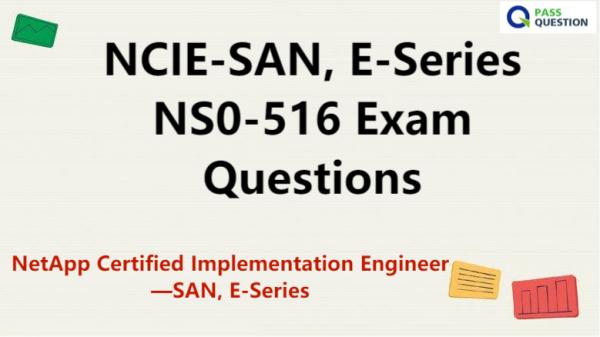NCIE-SAN, E-Series NS0-516 Exam Questions - NetApp Certified Implementation Engineer—SAN, E-Series
NS0-516 NetApp Certified Implementation Engineer—SAN, E-Series Exam is new launched, PassQuestion provides the latest NCIE-SAN, E-Series NS0-516 Exam Questions that give you all the relevant information about the NS0-516 exam.With the help of the NCIE-SAN, E-Series NS0-516 Exam Questions, you can prepare for your NetApp NS0-516 Exam on your own in a short time. PassQuestion promises you that you will be able to pass your NetApp NS0-516 test in just one attempt with confidence.

NetApp Certified Implementation Engineer—SAN, E-Series (NS0-516)
We recommend that NetApp Certified Implementation Engineer–SAN, E-Series candidates have six to 12 months of experience in installing, configuring, and managing E-Series storage systems in various SAN environments to provide reliable, high-performance block storage solutions.
The NS0-516 exam includes 60 test questions, with an allotted time of 1-1/2 hours to complete. In countries where English is not the native language, candidates for whom English is not their first language will be granted a 30-minute extension to the allotted examination completion time.
Exam Objectives
Storage Configuration
Describe how to setup alerting and notification for the E-Series system.
Describe how to create and administer Volume Groups or DDP and associated volumes.
Describe physical and logical storage requirements.
Describe the setup of CHAP for an iSCSI environment.
Describe when to use DDP or Volume Groups.
Documentation
Describe the process of reviewing and preparing a site for implementation of E-Series.
Describe the information you give a customer after deploying a solution.
Hardware
Describe the hardware components in an E-Series storage system.
Describe Fibre Channel, Ethernet, Infiniband and SAS cabling.
Describe the appropriate tasks for adding additional storage to an E-Series system.
Describe drive encryption features.
Host Side
Describe the different host connection options for E-Series systems.
Describe how to configure hosts for multipathing.
Management
Describe the administrative tasks for managing E-Series systems with SANtricity System Manager.
Describe the management security features in SANtricity System Manager and SANtricity Unified Manager.
Describe when and how to configure and use SANtricity Unified Manager.
Toolbox
Describe the tools required to design and implement an E-Series solution.
Protection
Describe how Data Assurance with media scan protects your data.
Describe SANtricity data protection features.
SAN
Describe the end-to-end network configuration for Fibre Channel and Ethernet.
Troubleshooting
Demonstrate the steps for troubleshooting an E-Series system.
Demonstrate how to analyze multipathing issues between a host and an E-Series system.
View Online NetApp Certified Implementation Engineer—SAN, E-Series NS0-516 Free Questions
A customer needs a system for a new solution that they are designing. They have provided you with the performance and capacity requirements.
In the NetApp Fusion UI, which workflow should you perform to help the customer?
A.Size and Recommend
B.Design a System Manually
C.Perform a Tech Refresh
D.Modify Existing Storage
Answer: A
A customer is experiencing performance issues on their NetApp E-Series system that is running with iSCSI host interface cards (HICs).
In this scenario, in which two locations in the GUI would you go to find detailed statistics for the ISCSI connections on this system? (Choose two.)
A.Home -> View Performance Details
B.Support -> Support Center -> Diagnostics -> View iSCSI Statistics
C.Support -> Support Resources -> Storage Array Profile
D.Settings -> System -> View ISCSI Statistics
Answer: BD
You need to run a command from the SANtricity System Manager GUI to mark drives as native by using the CLI tool on an E-Series system that is running System Manager 11.60 or higher.
In this scenario, where would you locate this tool?
A.Help -> CLI Command Reference
B.Support -> Support Center -> Diagnostics
C.Modify Existing Storage
D.Settings -> System -> Addons
Answer: D
What are two types of logical structures that volumes in the E-Series system use? (Choose two.)
A.volume groups
B.disk pools
C.volume pools
D.aggregates
Answer: AB
A company has just installed a NetApp EF600 storage array with an initial drive count of 12.A disk pool is created using all 12 disks. Benchmark testing now shows that system performance is far less than expected. Metrics show a very unbalanced use of the two PCle busses and drives.
In this scenario, which action addresses this problem?
A.Adjust cache block sizes to 8k.
B.Build two equally sized pools during disk pool creation.
C.Insert six drives into the first 12 slots and six drives into the last 12 slots.
D.Dynamically convert the volumes from RAID 10 to RAID 5.
Answer: C
What is the maximum number of FC host interface cards used per NetApp EF600 storage array?
A.1
B.2
C.3
D.4
Answer: D
A customer has a storage system that has been configured with multiple RAID 5 volume groups. The customer would like to reclaim capacity from the volume groups to use for a new application.
In this scenario, which action will solve this problem?
A.Consolidate free capacity for the volume group, remove the drives that are required for the new application, and let the volume group rebuild automatically.
B.Turn on thin provisioning for the RAID 5 volume groups to shrink the size of each volume, and then use the volume group drive removal procedure to reclaim the drives for the new application.
C.Shrink the size of the volume groups by using the volume group drive removal procedure, and then redeploy the drives as required for the new application.
D.Migrate all the data off each RAID 5 volume group, recreate the volume groups with fewer drives, and then migrate the data to the new RAID 5 volume groups.
Answer: D
You have two Linux hosts that must be connected over multiple paths to two NetApp E-Series systems. One with FC and the other with SAS.
In this scenario, which mutipathing driver should you use for each system to complete this task?
A.Use DM-MP for FC and SAS.
B.Use DM-MP for SAS and LVM for FC.
C.Use DM-MP for FC and LVM for SAS.
D.Use LVM for FC and SAS.
Answer: A
- TOP 50 Exam Questions
-
Exam
All copyrights reserved 2025 PassQuestion NETWORK CO.,LIMITED. All Rights Reserved.

